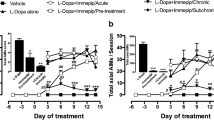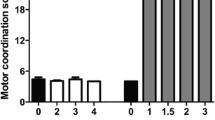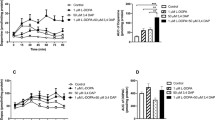Abstract
Rationale and objectives
Given that adenosine A2A antagonists appear to be therapeutic in several animal models of Parkinson’s disease (PD), we examined the extent to which caffeine and selective A2A and A1 antagonists could enhance contralateral forepaw stepping in the unilateral 6-OHDA-lesioned rat.
Materials and methods
Following unilateral injections of 12 μg 6-OHDA into the medial forebrain bundle (MFB), frequency of stepping with both front paws was counted separately as the paws were dragged anteriorally and laterally by a treadmill.
Results
The MFB lesions decreased contralateral stepping by 74–83%, and 8 mg/kg 3,4-dihydroxy-l-phenylalanine (L-DOPA) increased contralateral stepping by 25–26%. Caffeine given systemically (15 mg/kg) or into the dorsal striatum or external globus pallidus (GPE; 20–40 μg) increased contralateral forepaw stepping by 14%, 27%, and 26%, respectively, and enhanced the effect of 8 mg/kg L-DOPA on stepping. The selective A2A antagonist SCH-58261 (2 mg/kg) also increased stepping by 13% and enhanced the therapeutic effect of L-DOPA, whereas the selective A2A antagonist 8-cyclopentyltheophylline (3–7 mg/kg) and A1 agonist N 6-cyclopentyladenosine (0.03–0.2 mg/kg) had no effect. None of these drugs appeared to produce dyskinesic effects.
Conclusions
In this well-validated animal model of the akinesic effects of PD, caffeine and a selective A2A, but not an A1, antagonist were able to provide both monotherapeutic and adjunctive therapeutic effects. These data are consistent with the hypothesis that A2A antagonists may be therapeutic in human PD patients and indicate that the dorsal striatum and GPE are critical sites of therapeutic action.






Similar content being viewed by others
References
Ascherio A, Zhang SM, Hernán MA, Kawachi I, Colditz GA, Speizer FE, Willett WC (2001) Prospective study of caffeine consumption and risk of Parkinson’s disease in men and women. Ann Neurol 50:56–63
Bibbiani F, Oh JD, Petzer JP, Castagnoli N Jr, Chen JF, Schwarzschild MA, Chase TN (2003) A2A antagonist prevents dopamine agonist-induced motor complications in animal models of Parkinson’s disease. Exp Neurol 184:285–294
Brown SJ, Gill R, Evenden JL, Iversen SD, Richardson PJ (1991) Striatal A2 receptor regulates apomorphine-induced turning in rats with unilateral dopamine denervation. Psychopharmacology (Berl) 103:78–82
Carey RJ (1991) Chronic L-dopa treatment in the unilateral 6-OHDA rat: evidence for behavioral sensitization and biochemical tolerance. Brain Res 568:205–214
Cauli O, Morelli M (2005) Caffeine and the dopaminergic system. Behav Pharmacol 16:63–77
Cauli O, Pinna A, Morelli M (2005) Subchronic intermittent caffeine administration to unilaterally 6-hydroxydopamine-lesioned rats sensitizes turning behaviour in response to dopamine D1 but not D2 receptor agonists. Behav Pharmacol 16:621–626
Chang JW, Wachtel SR, Young D, Kang UJ (1999) Biochemical and anatomical characterization of forepaw adjusting steps in rat models of Parkinson’s disease: studies on medial forebrain bundle and striatal lesions. Neuroscience 88:617–628
Correa M, Wisniecki A, Betz A, Dobson DR, O’Neill MF, O’Neill MJ, Salamone JD (2004) The adenosine A2A antagonist KF17837 reverses the locomotor suppression and tremulous jaw movements induced by haloperidol in rats: possible relevance to parkinsonism. Behav Brain Res 148:47–54
Engber TM, Anderson JJ, Boldry RC, Papa SM, Kuo S, Chase TN (1994) Excitatory amino acid receptor antagonists modify regional cerebral metabolic responses to levodopa in 6-hydroxydopamine-lesioned rats. Neuroscience 59:389–399
Fenu S, Morelli M (1998) Motor stimulant effects of caffeine in 6-hydroxydopamine-lesioned rats are dependent on previous stimulation of dopamine receptors: a different role of D1 and D2 receptors. Eur J Neurosci 10:1878–1884
Fenu S, Pinna A, Ongini E, Morelli M (1997) Adenosine A2A receptor antagonism potentiates L-DOPA-induced turning behaviour and c-fos expression in 6-hydroxydopamine-lesioned rats. Eur J Pharmacol 321:143–147
Fink JS, Weaver DR, Rivkees SA, Peterfreund RA, Pollack AE, Adler EM, Reppert SM (1992) Molecular cloning of the rat A2 adenosine receptor: selective co-expression with D2 dopamine receptors in rat striatum. Brain Res Mol Brain Res 14:186–195
Fredholm BB, Persson CG (1982) Xanthine derivatives as adenosine receptor antagonists. Eur J Pharmacol 81:673–676
Fuxe K, Ungerstedt U (1974) Action of caffeine and theophyllamine on supersensitive dopamine receptors: considerable enhancement of receptor response to treatment with DOPA and dopamine receptor agonists. Med Biol 52:48–54
Fuxe K, Ferré S, Canals M, Torvinen M, Terasmaa A, Marcellino D, Goldberg SR, Staines W, Jacobsen KX, Lluis C, Woods AS, Agnati LF, Franco R (2005) Adenosine A2A and dopamine D2 heteromeric receptor complexes and their function. J Mol Neurosci 26:209–220
Grondin R, Bédard PJ, Hadj Tahar A, Grégoire L, Mori A, Kase H (1999) Antiparkinsonian effect of a new selective adenosine A2A receptor antagonist in MPTP-treated monkeys. Neurology 52:1673–1677
Jiang H, Jackson-Lewis V, Muthane U, Dollison A, Ferreira M, Espinosa A, Parsons B, Przedborski S (1993) Adenosine receptor antagonists potentiate dopamine receptor agonist-induced rotational behavior in 6-hydroxydopamine-lesioned rats. Brain Res 613:347–351
Kanda T, Jackson MJ, Smith LA, Pearce RK, Nakamura J, Kase H, Kuwana Y, Jenner P (1998a) Adenosine A2A antagonist: a novel antiparkinsonian agent that does not provoke dyskinesia in parkinsonian monkeys. Ann Neurol 43:507–513
Kanda T, Tashiro T, Kuwana Y, Jenner P (1998b) Adenosine A2A receptors modify motor function in MPTP-treated common marmosets. NeuroReport 9:2857–2860
Kanda T, Jackson MJ, Smith LA, Pearce RK, Nakamura J, Kase H, Kuwana Y, Jenner P (2000) Combined use of the adenosine A2A antagonist KW-6002 with L-DOPA or with selective D1 or D2 dopamine agonists increases antiparkinsonian activity but not dyskinesia in MPTP-treated monkeys. Exp Neurol 162:321–327
Kelsey JE, Langelier N (2005) Caffeine and the A2A antagonist SCH-58261 improve forepaw stepping in the unilateral 6-OHDA model of Parkinson’s Disease. Society for Neuroscience Abstracts 31: Program No. 424.14
Kelsey JE, Mague SD, Pijanowski RS, Harris RC, Kleckner NW, Matthews RT (2004) NMDA receptor antagonists ameliorate the stepping deficits produced by unilateral medial forebrain bundle injections of 6-OHDA in rats. Psychopharmacology (Berl) 175:179–188
Koga K, Kurokawa M, Ochi M, Nakamura J, Kuwana Y (2000) Adenosine A2A receptor antagonists KF17837 and KW-6002 potentiate rotation induced by dopaminergic drugs in hemi-Parkinsonian rats. Eur J Pharmacol 408:249–255
Lane EL, Cheetham SC, Jenner P (2006) Does contraversive circling in the 6-OHDA-lesioned rat indicate an ability to induce motor complications as well as therapeutic effects in Parkinson’s disease? Exp Neurol 197:284–290
Löschmann PA, Lange KW, Kunow M, Rettig KJ, Jähnig P, Honoré T, Turski L, Wachtel H, Jenner P, Marsden CD (1991) Synergism of the AMPA-antagonist NBQX and the NMDA-antagonist CPP with L-dopa in models of Parkinson’s disease. J Neural Transm Park Dis Dement Sect 3:203–213
Lundblad M, Vaudano E, Cenci MA (2003) Cellular and behavioural effects of the adenosine A2a receptor antagonist KW-6002 in a rat model of L-DOPA-induced dyskinesia. J Neurochem 84:1398–1410
Lundblad M, Picconi B, Lindgren H, Cenci MA (2004) A model of L-DOPA-induced dyskinesia in 6-hydroxydopamine lesioned mice: relation to motor and cellular parameters of nigrostriatal function. Neurobiol Dis 16:110–123
Maj J, Rawlow A, Sarnek J (1976) The effect of theophylline and caffeine on neuroleptic-induced catalepsy. Pol J Pharmacol Pharm 28:571–578
Malec D (1997) Haloperidol-induced catalepsy is influenced by adenosine receptor antagonists. Pol J Pharmacol 49:323–327
Matsuya T, Takuma K, Sato K, Asai M, Murakami Y, Miyoshi S, Noda A, Nagai T, Mizoguchi H, Nishimura S, Yamada K (2007) Synergistic effects of adenosine A2A antagonist and L-DOPA on rotational behaviors in 6-hydroxydopamine-induced hemi-Parkinsonian mouse model. J Pharmacol Sci 103:329–332
Morelli M, Wardas J (2001) Adenosine A2A receptor antagonists: potential therapeutic and neuroprotective effects in Parkinson’s disease. Neurotox Res 3:545–556
Olsson M, Nikkhah G, Bentlage C, Bjorklund A (1995) Forelimb akinesia in the rat Parkinson model: differential effects of dopamine agonists and nigral transplants as assessed by a new stepping test. J Neurosci 15:3863–3875
Paxinos G, Watson C (2005) The rat brain in stereotaxic coordinates, 5th edn. Academic, Burlington, MA
Pinna A, Di Chiara G, Wardas J, Morelli M (1996) Blockade of A2a adenosine receptors positively modulates turning behaviour and c-Fos expression induced by D1 agonists in dopamine-denervated rats. Eur J Neurosci 8:1176–1181
Pinna A, Fenu S, Morelli M (2001) Motor stimulant effects of the adenosine A2A receptor antagonist SCH 58261 do not develop tolerance after repeated treatments in 6-hydroxydopamine-lesioned rats. Synapse 39:233–238
Pinna A, Pontis S, Borsini F, Morelli M (2007) Adenosine A2A receptor antagonists improve deficits in initiation of movement and sensory motor integration in the unilateral 6-hydroxydopamine rat model of Parkinson’s disease. Synapse 61:606–614
Popoli P, Giménez-Llort L, Pezzola A, Reggio R, Martínez E, Fuxe K, Ferré S (1996) Adenosine A1 receptor blockade selectively potentiates the motor effects induced by dopamine D1 receptor stimulation in rodents. Neurosci Lett 218:209–213
Rose S, Jackson MJ, Smith LA, Stockwell K, Johnson L, Carminati P, Jenner P (2006) The novel adenosine A2a receptor antagonist ST1535 potentiates the effects of a threshold dose of L-DOPA in MPTP treated common marmosets. Eur J Pharmacol 546:82–87
Rose S, Ramsay Croft N, Jenner P (2007) The novel adenosine A2a antagonist ST1535 potentiates the effects of a threshold dose of L-dopa in unilaterally 6-OHDA-lesioned rats. Brain Res 1133:110–114
Ross GW, Abbott RD, Petrovitch H, Morens DM, Grandinetti A, Tung KH, Tanner CM, Masaki KH, Blanchette PL, Curb JD, Popper JS, White LR (2000) Association of coffee and caffeine intake with the risk of Parkinson disease. JAMA 283:2674–2679
Schiffmann SN, Jacobs O, Vanderhaeghen JJ (1991) Striatal restricted adenosine A2 receptor (RDC8) is expressed by enkephalin but not by substance P neurons: an in situ hybridization histochemistry study. J Neurochem 57:1062–1067
Schwarzschild MA, Agnati L, Fuxe K, Chen JF, Morelli M (2006) Targeting adenosine A2A receptors in Parkinson’s disease. Trends Neurosci 29:647–654
Shiozaki S, Ichikawa S, Nakamura J, Kitamura S, Yamada K, Kuwana Y (1999) Actions of adenosine A2A receptor antagonist KW-6002 on drug-induced catalepsy and hypokinesia caused by reserpine or MPTP. Psychopharmacology (Berl) 147:90–95
Simola N, Fenu S, Baraldi PG, Tabrizi MA, Morelli M (2004) Blockade of adenosine A2A receptors antagonizes parkinsonian tremor in the rat tacrine model by an action on specific striatal regions. Exp Neurol 189:182–188
Simola N, Fenu S, Baraldi PG, Tabrizi MA, Morelli M (2006) Involvement of globus pallidus in the antiparkinsonian effects of adenosine A2A receptor antagonists. Exp Neurol 202:255–257
Tronci E, Simola N, Borsini F, Schintu N, Frau L, Carminati P, Morelli M (2007) Characterization of the antiparkinsonian effects of the new adenosine A2A receptor antagonist ST1535: acute and subchronic studies in rats. Eur J Pharmacol 566:94–102
Wardas J (2003) Synergistic effect of SCH 58261, an adenosine A2A receptor antagonist, and L-DOPA on the reserpine-induced muscle rigidity in rats. Pol J Pharmacol 55:155–164
Wardas J, Konieczny J, Lorenc-Koci E (2001) SCH 58261, an A2A adenosine receptor antagonist, counteracts parkinsonian-like muscle rigidity in rats. Synapse 41:160–171
Xiao D, Bastia E, Xu YH, Benn CL, Cha JH, Peterson TS, Chen JF, Schwarzschild MA (2006) Forebrain adenosine A2A receptors contribute to L-3,4-dihydroxyphenylalanine-induced dyskinesia in hemiparkinsonian mice. J Neurosci 26:13548–13555
Xu K, Bastia E, Schwarzschild M (2005) Therapeutic potential of adenosine A2A receptor antagonists in Parkinson’s disease. Pharmacol Ther 105:267–310
Yu L, Schwarzschild MA, Chen JF (2006) Cross-sensitization between caffeine- and L-dopa-induced behaviors in hemiparkinsonian mice. Neurosci Lett 393:31–45
Acknowledgements
This study was based on research submitted by N. A. Langelier, B. S. Oriel, and C. Reedy as partial fulfillment for Bachelor of Science degrees. Portions of these data were presented at the Society for Neuroscience meetings in 2005 and 2006.
Author information
Authors and Affiliations
Corresponding author
Additional information
An erratum to this article can be found at http://dx.doi.org/10.1007/s00213-008-1361-y
Rights and permissions
About this article
Cite this article
Kelsey, J.E., Langelier, N.A., Oriel, B.S. et al. The effects of systemic, intrastriatal, and intrapallidal injections of caffeine and systemic injections of A2A and A1 antagonists on forepaw stepping in the unilateral 6-OHDA-lesioned rat. Psychopharmacology 201, 529–539 (2009). https://doi.org/10.1007/s00213-008-1319-0
Received:
Accepted:
Published:
Issue Date:
DOI: https://doi.org/10.1007/s00213-008-1319-0




